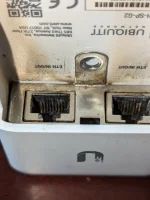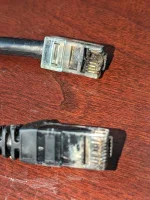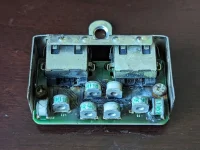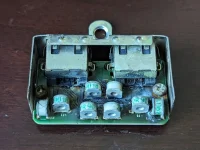Don't think you are dealing with a result of a lightning strike but possibly static bleeding off to ground. I have seen the ends of ethernet cable and other types of cable in equipment shelters arching to ground repetitively from static discharge during a storm.
You are using an out of date browser. It may not display this or other websites correctly.
You should upgrade or use an alternative browser.
You should upgrade or use an alternative browser.
More outdoor network cable damage
- Thread starter Donald
- Start date
Long Ethernet runs pick up strange things. A nearby lightning strike 2 years back took out my landscape lighting and a mac mini. The landscape wiring was not connected to my Ethernet plant, yet both were damaged. The one thing in common? Lots of west to east orientation. every item on my network needed a reboot, but the Mac mini was toast. A number of led landscape fixtures were crispy inside. Best I can tell, lightning hit the ground somewhere nearby.
even burying the cat6 could have similar affects, but it’s probably a lot more robust under ground than above it. you could also send a ground line back with it.
there’s an issue with having common equipment between multiple ground points. It’s advisable that a given system have one single point to ground, otherwise currents from earth can end up flowing through the buildings multiple ground points.
I think I read this week that we are under an elevated period of solar flare activity, which also introduces odd behaviors in long cable runs.
even burying the cat6 could have similar affects, but it’s probably a lot more robust under ground than above it. you could also send a ground line back with it.
there’s an issue with having common equipment between multiple ground points. It’s advisable that a given system have one single point to ground, otherwise currents from earth can end up flowing through the buildings multiple ground points.
I think I read this week that we are under an elevated period of solar flare activity, which also introduces odd behaviors in long cable runs.
My theory as to why the cable was burned is that your non-UL listed, non-primary protection, $12 (if I'm looking at the right one..) Unifi surge protector got hit with more than it could handle. Open it up and I bet you find burned components inside. Just be glad it didn't catch anything else on fire...
You get what you pay for. The ITW Lynx ones that are UL listed for primary protection cost more like $60 (EDIT: $100. Inflation).
I would also like to point out that ideally surge protecting devices should be in metal housings, not plastic housings that burn easily.
I would also like to point out that ideally surge protecting devices should be in metal housings, not plastic housings that burn easily.
At least if it's UL Listed it's been tested to handle a major surge and not catch fire in the process, even if it is in a plastic housing.
Donald
Thread starter
Also, those Unifi network protectors probably aren't primary surge protectors, but secondary ones (EDIT: Scratch that, they don't even appear to be UL listed....)
A primary surge protector is something like this:
https://www.itwlinx.com/products/su...s-cat6-cat6a-surge-protector/cat6-75-poe-rj45
(There's also a version of this with a 110 punchdown connection for the outside cable, which I prefer):
- Agency Approval UL Primary (497) and Isolated Loop (497B)
https://www.itwlinx.com/products/su...cat6-surge-protector/cat6-75-110-in-rj-45-out
(or if you want 110 punchdown on both the outside and inside cable):
https://www.itwlinx.com/products/su...rotector/cat6-75-single-line-surge-protection
Primary surge protectors can handle much more surge energy than a secondary one. All incoming communication lines are required per NEC rules to have primary surge protection.
I bought a couple of ITW LINX network surge protectors. Installed a new RJ45 connector on the CAT6 cable coming in the building and connected it to the ITW LINX surge protector. The connector again got burned after only one week.
If the surge protector was not doing its job it would pass the surge through the surge protector to the POE power injector. But this connector on the network cable coming into the surge protector.
I bought a couple of ITW LINX network surge protectors. Installed a new RJ45 connector on the CAT6 cable coming in the building and connected it to the ITW LINX surge protector. The connector again got burned after only one week.
If the surge protector was not doing its job it would pass the surge through the surge protector to the POE power injector. But this connector on the network cable coming into the surge protector.
Are you maybe getting water ingress into the cable that's shorting out the connector causing it to burn? The POE voltage is high enough and has enough current that any water that finds it's way into the connector could cause this. It's not unheard of for cables to develop a crack in the outer jacket which allows water into it---and if the connector at the surge protector is lower than other parts of the cable, water will flow into it.
Suggest putting a drip loop on the cable (lower than the surge protector RJ45) and slitting the cable jacket at the bottom of the drip loop. Any water in the cable will drain out there.
Assuming this isn't jelly-filled (flooded) cable. But even the construction of some jelly-filled cable, if it's shielded, could still allow water to flow between the shield and outer jacket.
Donald
Thread starter
I suppose that's possible. It's on my list to replace that cable with CAT6 shielded. I think it's CAT5E unshielded.Are you maybe getting water ingress into the cable that's shorting out the connector causing it to burn? The POE voltage is high enough and has enough current that any water that finds it's way into the connector could cause this. It's not unheard of for cables to develop a crack in the outer jacket which allows water into it---and if the connector at the surge protector is lower than other parts of the cable, water will flow into it.
Suggest putting a drip loop on the cable (lower than the surge protector RJ45) and slitting the cable jacket at the bottom of the drip loop. Any water in the cable will drain out there.
Assuming this isn't jelly-filled (flooded) cable. But even the construction of some jelly-filled cable, if it's shielded, could still allow water to flow between the shield and outer jacket.
But in one instance both the in and out jacks of the Unfi G2 surge protector were burned along with the RJ45 connectors.
Attachments
I suppose that's possible. It's on my list to replace that cable with CAT6 shielded. I think it's CAT5E unshielded.
Suggest using flooded/jelly-filled "icky pic" cable to prevent moisture problems. Worth noting that Contel used flooded telephone cable even for aerial applications. Was told that Verizon techs hate dealing with it!
But in one instance both the in and out jacks of the Unfi G2 surge protector were burned along with the RJ45 connectors.
Did you take the Unifi G2 surge protector apart to see what it looks like inside? The picture of the connector you posted looks like pins 2,3,4 eroded completely away. But pins 1,5,6,7,8 look ok. If you are using POE delivered on the orange and green (data) pairs and moisture got into the connector, well, pins 2 and 3 are right next to each other with POE voltage between them.
EDIT: Some Ubiquiti power injectors support 4-pair powering:
Pins 1, 2, 4, 5 (+) and Pins 3, 6, 7, 8 (-)
If you are using 4-pair powering, pin 2 is positive, pin 3 is negative, and pin 4 is positive.
These are the ONLY pins with opposite polarity right next to each other! And they are the only ones damaged.....things to make you go hmmm!
Last edited:
Donald
Thread starter
So I was thinking last night and think you are onto something. I replaced the connector on Sunday morning and Monday they had a lot of rain but no lightning. (I am told). That cable even with brand new connectors tests at 100Mbs with my Fluke cable verifyer. I should tests at 1Gbs or 10Gbs. This cable is on my list to replace but it comes into a building high up.Suggest using flooded/jelly-filled "icky pic" cable to prevent moisture problems. Worth noting that Contel used flooded telephone cable even for aerial applications. Was told that Verizon techs hate dealing with it!
Did you take the Unifi G2 surge protector apart to see what it looks like inside? The picture of the connector you posted looks like pins 2,3,4 eroded completely away. But pins 1,5,6,7,8 look ok. If you are using POE delivered on the orange and green (data) pairs and moisture got into the connector, well, pins 2 and 3 are right next to each other with POE voltage between them.
EDIT: Some Ubiquiti power injectors support 4-pair powering:
Pins 1, 2, 4, 5 (+) and Pins 3, 6, 7, 8 (-)
If you are using 4-pair powering, pin 2 is positive, pin 3 is negative, and pin 4 is positive.
These are the ONLY pins with opposite polarity right next to each other! And they are the only ones damaged.....things to make you go hmmm!
It's hard finding CAT6 with axial. Have not found found jelly filled CAT6 with axial. But I have lots of cable outdoors and this is the only one with this problem.
I am using a 60W POE injector so there should be power to 4 wires.
I will take apart the Unifi surge protector.
Also note the end of this cable at the telephone pole has never had any problems with a burned RJ45 connector.
Last edited:
You're doing the same thing over and over expecting different results.
Years ago, this system was designed and installed improperly. It needs to be completely redone. The first thing is relocate everything off of the utility poles. Work from the owned buildings. Use power wiring for long runs of power, and fiber or RF (especially 60 GHz) for long runs of data. Ethernet cable should be restricted to local interconnects. It's really hard to keep water out of outdoor Ethernet cable.
Years ago, this system was designed and installed improperly. It needs to be completely redone. The first thing is relocate everything off of the utility poles. Work from the owned buildings. Use power wiring for long runs of power, and fiber or RF (especially 60 GHz) for long runs of data. Ethernet cable should be restricted to local interconnects. It's really hard to keep water out of outdoor Ethernet cable.
Donald
Thread starter
Easier said than done. So this section that has caused me the most headaches is a row of cottages on both sides of the private road. Four telephone poles for power about 150' to 180' apart. No buildings owned by the association I can put any equipment in or on. No power available to me on any pole.You're doing the same thing over and over expecting different results.
Years ago, this system was designed and installed improperly. It needs to be completely redone. The first thing is relocate everything off of the utility poles. Work from the owned buildings. Use power wiring for long runs of power, and fiber or RF (especially 60 GHz) for long runs of data. Ethernet cable should be restricted to local interconnects. It's really hard to keep water out of outdoor Ethernet cable.
We do have a 400' fiber backhaul between two association owned buildings with switches inside the building plugged into a UPS and normal AC power. Just not possible for most of the campgrounds.
So I was thinking last night and think you are onto something. I replaced the connector on Sunday morning and Monday they had a lot of rain but no lightning. (I am told). That cable even with brand new connectors tests at 100Mbs with my Fluke cable verifyer. I should tests at 1Gbs or 10Gbs. This cable is on my list to replace but it comes into a building high up.
Cable's probably waterlogged.
It's hard finding CAT6 with axial. Have not found found jelly filled CAT6 with axial. But I have lots of cable outdoors and this is the only one with this problem.
Are you referring to the "spine" that some CAT6 has that separates the pairs? That isn't needed to meet CAT6 specs and is why most cable no longer has it, it just makes terminating the cable take longer.
I will take apart the Unifi surge protector.
Post pictures.
Also note the end of this cable at the telephone pole has never had any problems with a burned RJ45 connector.
Is the end at the telephone pole higher in elevation than the end at the building?
It's really hard to keep water out of outdoor Ethernet cable.
Use flooded cable and it solves that problem. Goo-gone to clean it up for termination.
Donald
Thread starter
Donald
Thread starter
Donald
Thread starter
Not sure they sell CAT6 with axial that is gel filled. It's typically for buried.Use flooded cable and it solves that problem. Goo-gone to clean it up for termination.
Not sure they sell CAT6 with axial that is gel filled. It's typically for buried.
You mean a messenger wire?
Inside of Unifi surge protector.
It looks like it got wet and corroded. The white and green deposits tell the tale.
Assuming you're going to run a new cable, whether gel-filled or not, I would terminate it into an RJ45 jack on the wall then use a patch cable to connect it to your surge protector. Wire it such that the cable enters the bottom of the jack.
Last edited:
Not sure they sell CAT6 with axial that is gel filled. It's typically for buried.
See if this is what you're looking for:
https://www.lanshack.com/Cat-6-550M...et-Cable-1000-Ft-Made-in-the-USA-by-CCT-P9954
Donald
Thread starter
Some call it axial and some call it a messenger wire.You mean a messenger wire?




